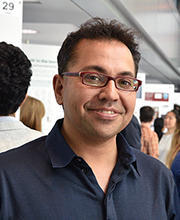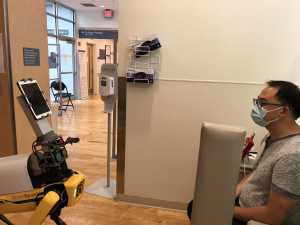Author Interviews, Brigham & Women's - Harvard, Diabetes, Ophthalmology / 16.06.2023
Brigham Study Finds Diabetic Damage in the Eye May Precede Onset of Diabetes
MedicalResearch.com Interview with:
Ali Hafezi-Moghadam, Ph.D., M.D
Director, Molecular Biomarkers Nano-Imaging Laboratory (MBNI)
Associate Professor of Radiology, Harvard Medical School
Brigham and Women’s Hospital
MedicalResearch.com: What is the background for this study?
Response: “It is very easy to answer many fundamental biological questions” said Richard Feynman in his 1959 address, where he also offered his simple and ingenious solution: “you just look at the thing!”[1].
As a biologist, I am familiar with the challenges surrounding looking at things in the context of life. There is no single device or technology that lets me simply see the answers to my questions. How does diabetes harm the tissues in the body? When exactly does the pathology start and which molecules and cells are involved? Trying to answer these questions, I have spent the past two decades innovating new ways of quantifying expression of molecules in the living organism [2].
At the same time to study diabetes, we needed a realistic rodent model that mirrors the human disease. In collaboration with KC Hayes[3], we first introduced the Nile grass rat (NGR, Arvicanthis niloticus), a gerbil that recapitulates the main features of the human type 2 diabetes [4]. For visualization of early changes, the eye offers a unique site. Much of my lab’s work focused on the first effects of diabetes in the retina, the site of the neurons that perceive light in the back of the eye [5], [6], [7]. In recent studies, we focused on how diabetes affects the lens in the eye of our animals [8], [9].
Diabetes is a major risk factor for cataract formation, a condition during which the lens loses its original transparency to visible light. How diabetic cataracts are formed is not well understood. A popular and prevailing theory, termed “sugar cataracts”, has been around for over half a century. According to the sugar hypothesis of cataracts, the excess levels of the sugar molecule, glucose, in the lens are transformed through the polyol pathway into the sugar-alcohol sorbitol. The resulting osmotic dysbalance leads to swelling of the fiber cells and opacity of the lens. Even though the sugar hypothesis has never been proven, it was generally accepted and remained unchallenged for a very long time. That is where our latest experimental results became relevant.
(more…)






















 Benjamin E. Gewurz MD, PhD
Broad Institute of MIT and Harvard, Cambridge,
Division of Infectious Disease, Department of Medicine, Brigham and Women’s Hospital,
Department of Microbiology, Harvard Medical School
Boston, MA
MedicalResearch.com: What is the background for this study?
Response: When the Covid-19 virus infects cells, it takes over and redirects our cells resources towards the projection of virus building blocks and new viruses. Building blocks include large amounts of RNAs that encode for the viral proteins, much as the mRNA vaccines direct our bodies to make the spike protein. We wondered how the virus changes cell metabolism in order to support the synthesis of vast amounts of viral RNAs within hours of infection.
Benjamin E. Gewurz MD, PhD
Broad Institute of MIT and Harvard, Cambridge,
Division of Infectious Disease, Department of Medicine, Brigham and Women’s Hospital,
Department of Microbiology, Harvard Medical School
Boston, MA
MedicalResearch.com: What is the background for this study?
Response: When the Covid-19 virus infects cells, it takes over and redirects our cells resources towards the projection of virus building blocks and new viruses. Building blocks include large amounts of RNAs that encode for the viral proteins, much as the mRNA vaccines direct our bodies to make the spike protein. We wondered how the virus changes cell metabolism in order to support the synthesis of vast amounts of viral RNAs within hours of infection.



 MedicalResearch.com: What is the background for this study? What are some of the functions that Dr. Spot can facilitate?
Response: During the COVID-19 pandemic, we wanted to consider innovative methods to provide additional social distance for physicians evaluating low acuity individuals who may have COVID-19 disease in the emergency department. While other health systems had instituted processes like evaluating patients from outside of emergency department rooms or calling patients to obtain a history, we considered the use of a mobile robotic system in collaboration with Boston Dynamics to provide telemedicine triage on an agile platform that could be navigated around a busy emergency department. Dr. Spot was built with a camera system to help an operator navigate it through an emergency department into a patient room where an on-board tablet would permit face-to-face triage and assessment of individuals.
MedicalResearch.com: What is the background for this study? What are some of the functions that Dr. Spot can facilitate?
Response: During the COVID-19 pandemic, we wanted to consider innovative methods to provide additional social distance for physicians evaluating low acuity individuals who may have COVID-19 disease in the emergency department. While other health systems had instituted processes like evaluating patients from outside of emergency department rooms or calling patients to obtain a history, we considered the use of a mobile robotic system in collaboration with Boston Dynamics to provide telemedicine triage on an agile platform that could be navigated around a busy emergency department. Dr. Spot was built with a camera system to help an operator navigate it through an emergency department into a patient room where an on-board tablet would permit face-to-face triage and assessment of individuals.


